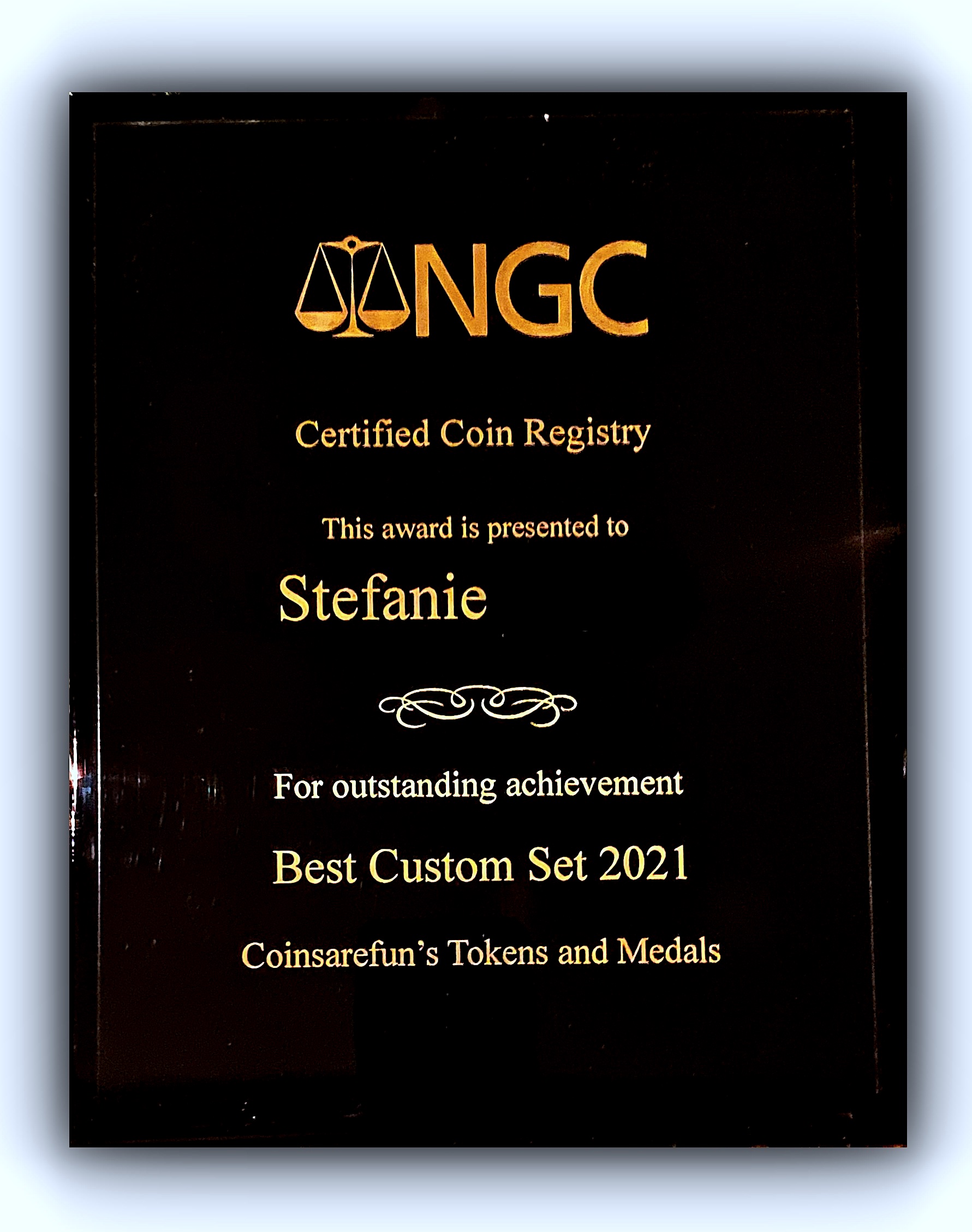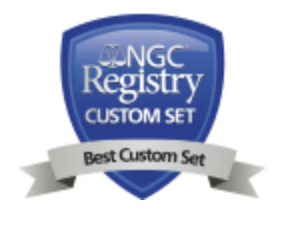All written material & coin images property of
Christopher Talbot Frank, CTF Error Coins Website
Error coin collecting is a very fascinating field of numismatics. Errors offer unique coins for the expert collector as well as exciting opportunities for the those new to the field. There are many types of mint errors from common minor defects to major dramatic one-of-a-kind miss strikes which error enthusiasts so seek out. A great start for new collectors is to search rolls of uncirculated coins for errors you can get from the bank at face value. Look for minor errors like die cracks, die fills, blank planchets, die polishing errors, small clips, and many more. Major mint errors can also be found in bank rolls like on center double strikes, missing clad layer, clashed dies, off metal, double denomination, die adjustment strike, dropped letter, cracked die, major clips, struck thru capped die as well as quite a few others.
The more dramatic mint errors won't be found in bank rolls, but can be purchased from error coin dealers , some regular coin dealers, coin shows, eBay, and other auctions. These dealers get their errors from other dealers, coin counting rooms where the odd sized coins are rejected, wholesalers, and from private collections. Even the novice collector can buy some major errors at very reasonable prices. Major common date off centers, broadstrikes, and clips can be found for around ten dollars. Many error collectors collect a "type set" of different types of errors for study. Others collect off center errors by date to put together a date set, but some dates are quite rare, so this is not an easy set to do. There is such as vast variety of mint errors that you could put together numerous subsets with any criteria to form your error coin set.
One word of caution; there are coins out there that have been faked to look like errors as well as coins that got defaced for the fun of it. Many of these end up on internet auctions and are knowingly or unknowingly listed as an "error" coin. Learn what to look out for and ask yourself, "How did this happen? Could it have been done in someone's garage or machine shop? Is this only possible by a die striking error at the mint?" Experts can spot most fakes in seconds.
There are so many different types of errors and such a broad price range that almost anyone can enter this very interesting and educational field of coin collecting. I encourage you to seek out errors and look at images of some of the more dramatic mint errors that have great eye appeal. Multiple errors on one coin are also sought after as they are usually one-of-a-kind. Most collectable examples of mint error coins will stop you in your tracks and you'll just say "WOW!"
The following are examples of some of the more popular error type coins.
This is by no means a complete list as there are hundreds of types of errors.
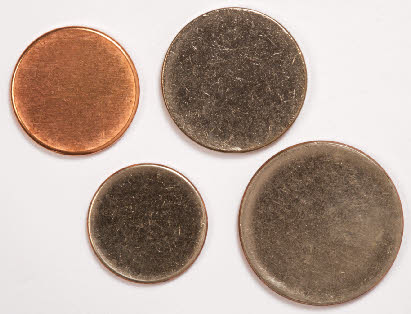
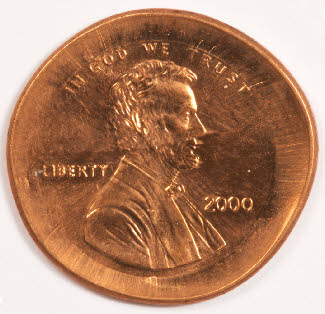
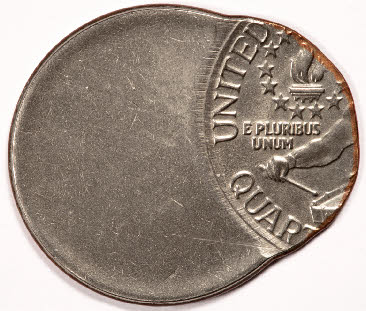
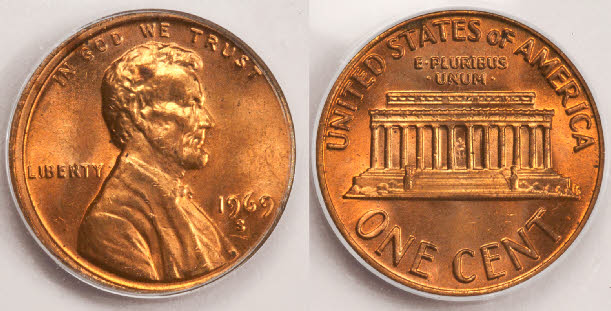
![Clip errors happen when the planchets are punched out of the prepared metal strips and the punch overlaps creating a crescent shaped planchet.[br]There are also straight clips, ragged clips, and elliptical clip errors. Clip errors happen when the planchets are punched out of the prepared metal strips and the punch overlaps creating a crescent shaped planchet. There are also straight clips, ragged clips, and elliptical clip errors.](/images/article_images/US_Coins/MintErrors/clip_errors.jpeg)
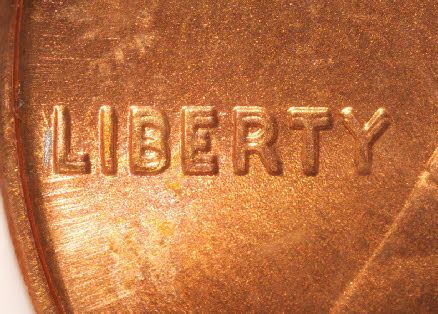
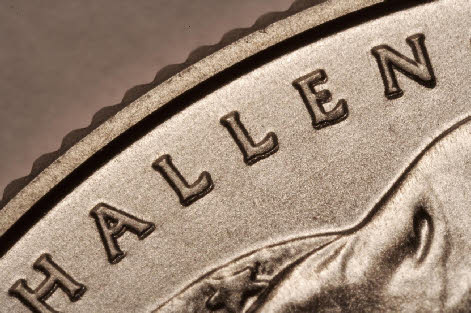
Double Die vs Machine Doubling. Double die errors have the doubling in the hub, while machine doubling errors happen from a worn out, sloppy die.
Double die errors can be very valuable while machine doubling adds no extra premium.
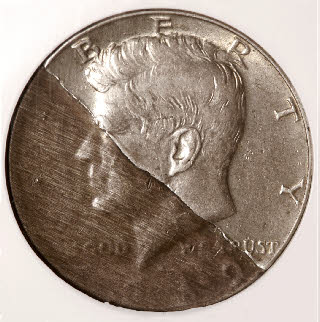
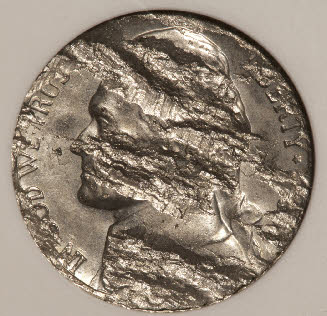
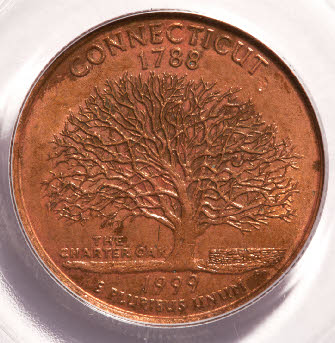
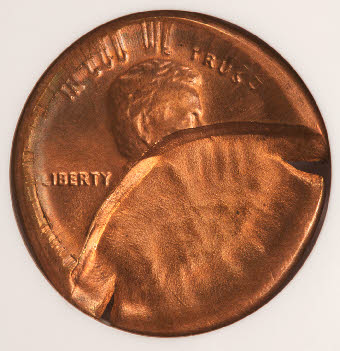
An Overview of Counterfeit Detection
Written by “Fruitloops”
Counterfeit coins are becoming more of a problem as time passes. It is all too apparent. and grading company slabs are even being targeted. Fakes can range from crude (cast copy), to excellent (transfer die struck). Many gold coins coming from the middle east are exceptional, and it is a rule to remember that some of the best counterfeits, if it looks too good to be true, it probably is.
In the summer of 2002, first brought to the attention in the magazine Coin World, a very strange error coin came. The existence of a "mule" consisting of the obverse of a 1959-D cent and the reverse (wheat ears) of a cent from 1958 (or earlier). To Bob Campbell, a famous authenticator, the coin just didnt "look righf', he said "Something about the coin just didnt seem righf', later he said, "The fabric was there and everything pretty much looked correct, but it justfelt wrong-- not a physical kind of"feel" but more of a gull ike feeling." Indeed, the coin looked too good. How could such a spectator error go unnoticed ? That's because the coin was a forgery, different from a counterfeit. Generally counterfeit coins are contemporary, they are meant to be used in circulation. Where as a forgery, is made to fool numismatic experts and dealers.
More about the coin, it was actually made by infamous Mark Hofmann. He once said, "If I can produce something so correctly, so perfect that the experts declare it to be genuine, then for all practical purposes it is genuine. There is no fraud involved when I sell it."
In his book Numismatic Forgery, Charles M. Larson. who was the sergeant at night when he worked at the prison which Mark Hofmann was sentenced to, talked and interviewed Hofmann several times. Hoffman told Charles that he used an ingenious method of creating dies using an electroplating process.
You can read more about Numismatic Forgery in Charles Book, Numismatic Forgery
A Few Rules of Thumb:
Generally there are different types of creating counterfeit coins and how to spot them. Many times counterfeiters would actually melt down a very worn (but authentic) $20 double eagle to make several $1 gold coins which have a high numismatic value relative to their intrinsic, or gold content. This way the gold used has the same fineness as genuine mint gold, as well as the proper alloy. (Because the worn $20 is a genuine coin, it can be purchased for less than fifty dollars over spot of the gold it contains.)
As a general rule, it is said that coins that are EF or lower. chances are it is genuine.
Overview of different counterfeit types

Cast counterfeits:
Generally, cast counterfeits are the most poorly made. Often you will see blobs of metal through the letters or devices of the coin.
Often times. as well they can be identified by a seam that runs about the outside edge of the coin.
Casting can be made from plastic molds, using centrifugal force. Cast counterfeits, unlike transfer die high quality counterfeits.
are often underweight and may use a different material (such as tin). instead of silver if the coin is a silver coin.

Electrotypes:
These are generally used by museums.They are made by impressing a genuine coin nito a soft substance and electroplating the negative impression, creating a positive shell. Generally the edge can give this away, as with cast counterfeits many electrotypes have a seam around the edge.
Generally when "rung" electrotypes will not sound right, because of the process made.
Transfer dies:
These are the most common used and also the most deceptive.
The counterfeiters actually create a working die this time, but since they are using the same die all imperfections struck from those dies will go onto the coins.
Sometimes there will be a blemish on the die, and the counterfeiter tries to remove it.

This leaves short, stubby lines on the finished coin called tool marks. Many Indian head gold coins have tool marks in the recess of the neck.
Also since the counterfeiter is using the same die, there are things known as repeating depressions. The reason they are repeating is because any coin struck with that die will have the same imperfection. A genuine coin must be sacrificed as a host to make the transfer dies. Because the genuine coin used will have contact marks, the metal flows into the planchet creating what is known as depressions on the counterfeit coin.
High quality (probably middle eastern) struck counterfeits. all returned body bagged as counterfeit by PCGS.

These are small, often circular craters in the coin which often blend with the surrounding field, but because they were struck, they have luster inside them.
Often a contact mark is shiny and does not blend in with the fields of the coin because the metal is disrupted.
It is said that the most common counterfeited coins are the ones collectors buy the most. because of demand.
This is what Charles said in his book, Numismatic Forgery. For some reason, there are few counterfeit coins before 1840.
A counterfeit gold coin (probably another base metal) in a counterfeit PCGS slab.
This was found on eBay from a seller overseas.

Counterfeiting slabs are becoming more of a problem and NGC has taken actions with this in their slabs. PCGS has also taken action, issuing a warning to be careful of counterfeit PCGS slabs, and how to spot them.
Spark Erosion Counterfeits:
These are generally easy to detect because how they are made.
In this process, A genuine coin is put in an electrolytic bath where the coin faces the counterfeiter's die steel.
An electrical current spark is charged through the coin so that the spark goes across the shortest gap between the coin and die, creating the coin's design onto the steel die
Often times these coins are heavily pitted because of this process .. so the counterfeiter's polish the dies to make up for this.
These can be detected by their lumpy devices, and are often found on small type coins like cents and dimes.
Some rules of thumb:
Because of the transfer die process. many gold coins use this. Also, because a genuine host coin is used and a crude die is made, called an impact die, there is generally loss of detail on the counterfeit coin.
A good thing to do is look at many genuine coins in a particular series. Once you know what a genuine coin looks like, in general, counterfeits become much easier. Generally genuine coins have sharp, crisp letters and devices. numbers as well. Weak fatty letters and devices are a dead giveaway the coin is counterfeit. Please remember that generally you need many different attributes to determine a coin thought to be counterfeit, for example if you just find a depression or two on the coin, this is not enough to deem it counterfeit. Depressions can also be mint made, but often they do not have the luster that a counterfeit coin has.
Another thing to look for on counterfeit gold coins are spikes from the denticles or devices, such as stars of the coin.
I'm actually not sure what spikes are caused from, but I know that spikes along from the denticles on the coin are not enough to deem it counterfeit;
as discussed earlier because sometimes genuine coins have them too. According to expert numismatic authentication expert Randy Campbell, about 3% of genuine coins have them.
Color is another thing to look for on counterfeit coins. Generally sometimes, the color is just "off' and it doesnl look right.
This can only come with years of looking at genuine coins and knowing your series well. For example, branch mint coins struck in Charlotte, North Carolina usually have a red hue, where coins minted in Dahlonega, Georgia, or New Orleans. and also Louisiana often have a greener cooler.
Note: I have read in an issue of Numismatic News that coins from the southern mints, such as Dahlonega and new Orleans, the coins often have a lighter color, and this is because these coins have a higher silver content in them. mixed with the gold alloy produces a different color.
This seems to contrast with what I posted earlier ... but I believe it is the correct one.
On cast counterfeits, often the coin is not the correct weight, so you may need to weigh them.
Many transfer die struck gold coins are the proper weight and fineness (because of, in some cases, a melted double eagle makes several gold dollars).
Many counterfeiters do not take the time, unlike the mint. to polish their dies.
Therefore lots of die polish relevant in protected area's of the coin, are a good sign or a possible sign it is genuine.
Often times what counterfeiters will do is buy a blank planchet, which the mint has made (on accident) (such as a silver dime planchet for a 16-D mercury) and use that to create the counterfeit coin.
I hope this information helps learning more about counterfeits.
The key is to look at as many coins certified by the Top TPG's, that are genuine, so you know anything that doesnt look genuine is suspect.
Credit goes to Numismatic Forgery, United States Gold counterfeit detection guide by Bill Fivaz, and the guide to grading and counterfeit detection by PCGS.
Counterfeit dies made from Chinese counterfeiters:

Excerpt from Bill Fivaz book, on counterfeit gold. Notice the linear depressions. (which is from when something gets stuck on the die and is struck, leaving a depression), and the luster within the other depressions:

The following are notes taken from my ANA counterfeit detection seminar I took at the ANA Phoenix show with teacher Brian Silliman.
They are filled with many tips and tricks, I hope you enjoy them.
Notes from authentication, grading, and conservation class taken at the ANA national money show pre- convention seminar in March, in Phoenix.
Authentication:
Contemporary counterfeits are circulated
Q: What are altered coins?
~Date alteration:
A: One or more of the digits are "altered" so the coin can be passed as a more valuable date.
TIP*****First coins made by counterfeit dies look too prooflike (PL). unreal. Worn down counterfeit coins made by counterfeit does look more deceiving.(Worn out dies)
TIP*****Bay Area counterfeits-- (Look up)
Mint mark alteration:
The addition or removal of a mintmark to produce a more valuable specimen.
Alterations:
Form of a counterfeit coin. Note: This is not the same as surface alteration on a coin.
Depressions.--> Depressions are contact marks on an original coin used as a host (sacrificed) on a counterfeit die to make counterfeit coins.
Interesting note
Struck counterfeits are most often seen on gold coins.
Alterations are most commonly seen on all key dates or mintmarks and on most better dates.
TIP*****Take the How To Detect Counterfeit and Altered US coins ANA correspondence course.
TIP*****Most struck counterfeits are uncirculated.
Recommended references for further reading:[list][')ANA Reprints from the numismatist volumes 1 & 2
• Copies of Authentication Bureau Column The numismatist. (c.) 1991-2001 and 2007
• Clippings from coin world and numismatist news
• Pick up counterfeit coin detector, Bill Fivaz (pocket reference) TIP --> (You can pick these up on ebay.
They offer many genuine diagnostics for the key dates. including the 1916 D mercury dime and three legged buffalo.
Once you know the genuine diagnostics its much easier to authentication the altered mint marks or specifics.
I got one from the class. a pocket reference from Bill Fivaz hand signed by him)
Other references:
• Misc. counterfeit reports
• National collectors lab
• ANA cert. service
• T.B.S.C.C reports and bulletins recourse
• ANA Mediation service
• PNG Arbitration service
• US postal inspector(?? No idea on this one)
• Federal trade commission
• Legal action.(?? I think this section was on what to do if you had your coins stolen or if you had a counterfeit coin to give it over to the secret service. Not sure)
For Struck counterfeits:
• There are numerous methods used to produce
• Die struck coins are superior in quality to cast methods
For cast counterfeits. some diagnostics generally seen on these:
• pimples and pits (air bubbles)
• edge seams
• weight and diameter are sometimes off
Electrotvpes:
Electrotypes are a soft impression in wax . they are then plated. Lots of ancient coins are done this way. They also often have an edge seam.
More about depressions:
~Depressions have metal Oow through them, bagmarks are shiny surrounding the bagmark.
The vast majority of spark erosion counterfeits are copper.
General counterfeit information:
The more counterfeits made the more loss of detail from that die; so the coin is therefore struck with more force to compensate.
Gold coins often have the denticles and on the 1908 S and 1909 S Indian cent.
Genuine diagnostics for several key date coins and alterations:
1) The 1909 S VDB
Genuine specimens should have a die chip in the s, there is a deficient on upper Ioupe serif, parallel sides on left. (?)
Check for tooling, scratches. displaced metal polishing or cleaning to conceal evidence
TIP*****embossed mint marks are made by drilling a hole into the coin. Watch out for them.
2) 1937 D Buffalo Nickel
Here's a good way to remember the diagnostics on a genuine unaltered buffalo nickel of this date.
"If the buffalo's pi-ing they legs missing"
3) 1901 S 25 c-- Watch for seams around the mintmark.
4) 1917 Type 1 25 c-- Watch outtor re- cut lines
5) 1932 D and S 25 c-- Check for seams stuck on coin
TIP*****On authentication, you generally cannot deem a struck coin counterfeit with only one depression.
Generally you need other signs such as spikes from the denticles (Although about 3% of coins with spikes from the denticles are genuine) or multiple depressions.
• On the 1893 S mint alterations are most common.
• On the 1894 S $1 look for a die gouge on the leg of the eagle. (on genuine pieces)
• On the 1895 silver dollar the date rises. usually the 5 rises the most.
6) 1928 S $1 peace
Look for light die polish in rays, S mint marks on peace dollars usually sits in a depression, fat.
Countetfeit gold coins information
There are 2 types of fields on gold coins.
1) The Flat Field Type:
The Oat field type is on the :
$1 gold liberty, $2.5,$5,$1 0, and $20 liberty head and the $3 Indian Head Flat field coins have denticles, cartwheel luster type.
2) The Sculpted Field Type:
Indian head $1 0 gold and Saint Gaudens $20 gold
Diagnostics for counterfeit pieces: Loss of fine detail, weak fat appearance in the letters. numbers. stars etc, denticles separate, uneven.
Known as "toothy' tool marks through the letters. field and numbers.
TIP*****The instructor told me he was able to go on eBay and within 5 minutes find a counterfeit US gold coin from just the look of the coin.
On this particular coin, and on some counterfeit gold US coins, there is a halo or dishing effect on the transition of the field to the denticles.
It is a bright circle around inside of the denticles.
Characteristics of genuine coins:
(Sometimes the best way to tell if a coin is counterfeit is to know the genuine characteristics. Here are a few of them)
1) Flat even fields
2) good luster and metal Oow
3) clear, well formed denticles
4) fine details
5) good relief
6) fine die polish (counterfeits often show loss of detail everywhere)
7) Meets mint specifications for weight, diameter and metal content.
8) die cracks. These are seldom seen on counterfeits
9) denticles are sharp. (TIP! Some counterfeits also have fatty stars. See above)
10) A halo is a bright circle on edge of coin (see above)
Other characteristics of counterfeit gold:
1) Loss of relief
2) Raised bumps, ("Pimples")
Interesting Fact: There was once a infamous counterfeit who "signed" his work with the omega sign.
No one knows if he ever was caught, but he counterfeited high relief 20 dollar eagles very well.
He also counterfeited $3 Indian Princess gold. One way you can tell is to look for the omega symbol in the top of"R" on this $3 coin.
TIP*****Rotate a counterfeit coin under a good light source to spot depressions
TIP*****A linear depression is when lint gets betvveen dies. These often are long, thin, with luster.
(These are sometimes on genuine coins too, as well as other depressions)
TIP*****It's harder to use the fields on the Indian Head for authentication due to the incuse design. (On the 2 1/2 and 5 dollar pieces).
Instead, on genuine specimens. look for die polish lines in the recess of the neck. These are short parallel lines...On counterfeit specimens, look in stars for tool marks.
TIP*****Die polish are fine lines over the entire coin. This is from when the dies were heavily polished at the mint.
TIP*****$10 Indians sometimes have depressions on the letters. That's a good place to look for them.
Contact marks are shiny, where as counterfeit depressions generally have luster in them. metal Oow through them. and match the surface
characteristics outside of the depression in relative to the depression. They also often have soft, rounded surfaces.
Regarding the 3 legged buffalo error here are some pointers:
Brian said, "If the buffalo's pi-ing, they legs missing." referring to the stream of"pee"
1. The leg is missing (due to it being polished oft) but the roof is still visible.
2. There is a longer appendage (stream of 'pee) from the bison's belly, with a long, raised arc of "bumps" leading down to the ground
3. There is a "moth-eaten" appearance to the bison's hide, especially on the rear leg.
4. The E PLURIBUS UNUM over the bison's back is thinner and further away from the back.
(Note: These are all on GENUINE examples, if you know what a genuine one looks like, anything but will look suspect.)

An Introduction to the Early Two and a Half Dollar Gold Pieces
Written by:By Bill Jones
All material and images owned by Bill Jones
Back in 1960 when I was just starting to push Lincoln Cents into my Whitman penny folders, I was very surprised when my mother told that she had seen two and a half dollar gold pieces when she was child. That denomination seemed weird to me because there was no paper money equivalent to it. Of course to all 19th century Americans and to the first generations of the 20th century, the two and a half dollar gold coin or quarter eagle was as ordinary as a silver dollar or the other gold denominations of that era. One didn’t see those coins every day because they did not circulate that much, but everyone was aware that they existed.
Although a $2.50 coin may seem odd today it was actually a logical extension of our monetary system. The Coinage Act of 1792 created a hybrid of the decimal money system, which the United States introduced, and the Spanish system of “bits” or “eighths” of a dollar that the United States inherited. The major silver unit or dollar was divided into subsidiary parts, which included the half-dollar or “four bits” and the quarter-dollar or “two bits.”
Similarly the ten dollar gold piece or “eagle,” which was the major gold unit, was divided into its half eagle and quarter eagle parts.
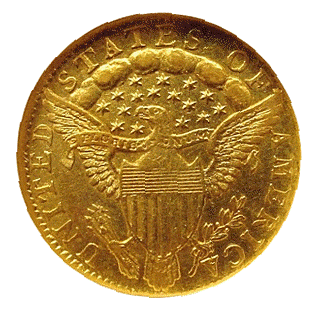
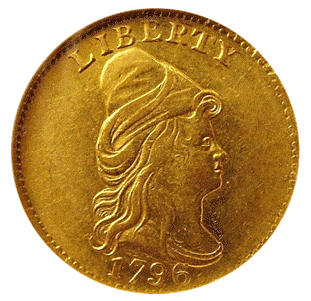 The U.S. Mint issued the first quarter eagles in 1796.
The U.S. Mint issued the first quarter eagles in 1796.
Those coins featured a bust of Ms. Liberty wearing a hat and hairstyle that was the latest fashion of the time. The reverse featured a heraldic eagle that would become the standard design for all U.S. gold and silver coins by the year 1800. The very first quarter eagles had no stars on the obverse, which was an unusual feature. All of the other U.S. gold and silver coins had stars on the obverse, and designer Robert Scott quickly changed that when he made the second quarter eagle obverse die later that year. With a mintage of only 963 pieces the 1796 “no stars” quarter eagle is a rare coin, but the “with stars” is even rarer with a smaller mintage of only 432. Still the “no stars” variety is a one year type coin that sells for higher prices that the “with stars” piece.
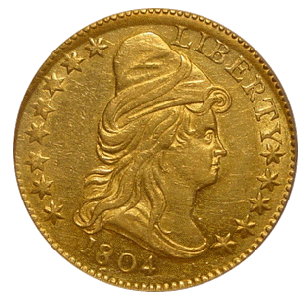
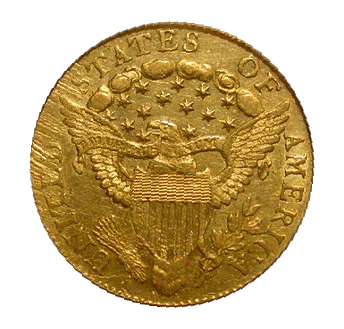
The Capped Bust Right Quarter Eagles were issued for most years from 1796 to 1807, but they would never be minted in very large quantities. Back in the early days of the Philadelphia Mint banks, businesses and wealthy individuals were encouraged to deposit gold and silver for coinage into United States currency. Since these depositors could specify the denominations they wanted, the coins of choice were the silver dollar and the five and ten dollar gold pieces. These demands were heavily influenced by the fact that the larger coins were more convenient to use in large transactions, such as payments for purchases overseas.
The dime sized quarter eagles were ordered largely on a whim according to the late numismatic authority, Walter Breen. The most frequent requests for them came from two Philadelphia banks, the Bank of Pennsylvania and the Bank of the United States. Since most of these early coins are usually in VF to AU, it would appear that these coins spent a fair amount in bank vaults and comparatively little time in people’s pockets and purses. These coins were also popular for use as jewelry, and more than a few of these pieces have been salvaged from loops and broaches. Although one must be careful examine these pieces for evidence of jewelry use, pieces that show such problems are still quite valuable because the coins are so scarce.
It was no accident that the diameters of the early gold coins coincided with those of certain silver pieces. The similarity in size between the dime and quarter eagle, the quarter and the half eagle and the half-dollar and the eagle made it possible for the mint to use some of its tools interchangeably. Interestingly enough the only known instances in which two denominations shared the same die have been found between the dime and the quarter eagle. There are varieties of 1800, 1802, 1803, 1804 and 1807 dimes that share a reverse with varieties of quarter eagles.
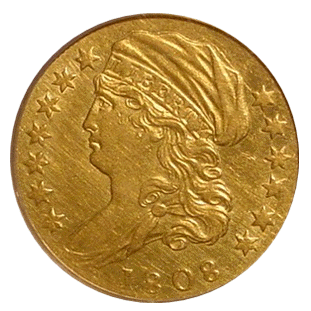
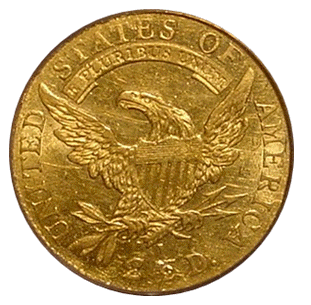
In 1808 newly hired mint engraver, John Reich, redesigned the quarter eagle as a part of his assignment to replace every coin design that was then in production at the first U.S. mint. Reich’s design featured a buxom wench, who his detractors claimed was patterned after “his fat mistress.” Unlike the other designs that he created, Reich’s Capped Bust quarter eagle was produced for only year. That resulted in the creation of the rarest type coin in the United States series. Only 2,710, 1808 quarter eagles were struck. John Dannreuther, who co-wrote the book Early U.S. Coin Varieties, estimates that only 125 to 150, 1808 quarter eagles exist in all grades. Among type collectors and gold coin enthusiasts, acquiring an 1808 quarter eagle is a numismatic milestone.
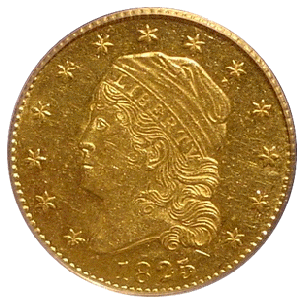
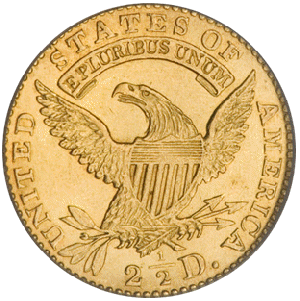
The Mint did not issue any quarter eagles from 1809 to 1820. In 1821 the quarter eagle reappeared with a design that Reich had created for the half eagle in 1813. By this time Reich had left the mint, and chief mint engraver. Robert Scott, who was 77 years old and well past his prime, cut the dies from Reich's design. This depiction of Ms. Liberty was a very matronly lady, depicted in low relief with a stout face and blunt features. Once more the annual mintages were small.
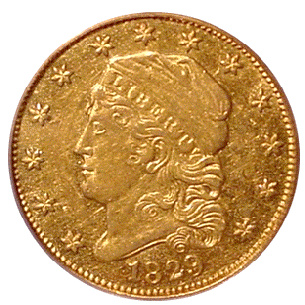
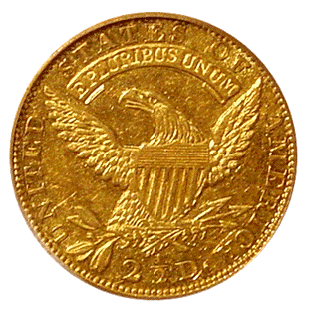
Some collectors and dealers call these early U.S. gold coins “the fatty $5 and fatty two and half dollar” gold pieces. In 1829 the mint modified its production procedures for the quarter eagle by introducing the close collar to the denomination. In the past the edge reeding had been applied to the coin in a separate operation. Starting in 1829 the blank planchets were dropped in a collar and the reeding was squeezed on the coin at the same as it was struck. This change eliminated a step in the coining process and gave the finished coins a more uniform diameter. The closed collar coin dies, which were created by mint engraver, William Kneass, differed slightly from the open collar pieces. Most collectors recognize them as a separate type. Once more the mintages were very low; the coins are very scarce; and they almost neverseen in circulation. In fact, they were most frequently used to pay members of Congress who demanded that they receive their salaries in gold.
By 1834, the United States gold coins were in the doldrums. The melt value of the coins exceeded their face value and the coins received little use as a result. But change was in the wind. Andrew Jackson had been elected to a second term as President, and he was posed to enact his own version of monetary reform.
Join in on the discussion of Classic Commemoratives
Introduction to U.S. Classic Commemorative Silver Coins
Written by: LeeG
All images in this lesson are of current events in 1892 when Classic Commemoratives were first proposed to the marketplace. Coins are an ideal way of expressing ideas or to mark historical events.
The United States Congress has been authorizing commemorative coins since the first commemorative half dollar was created in 1892 honoring the 400th anniversary of the discovery of the New World by Columbus.
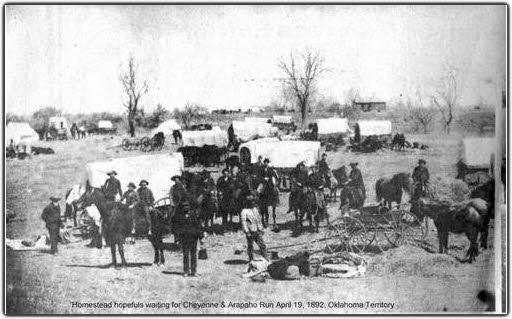
Most commemorative coins are issued at a premium above their face value. The additional funds are used for particular projects or charitable organizations. The Columbian half dollars, for example, were sold at $1 each at the Columbian Exposition in 1893 and the 1936 Cincinnati Music Center commemorative half dollars; made in Philadelphia, Denver and San Francisco;are sold in sets at the price of $7.75.
 train](/images/article_images/US_Coins/EarlyCommemoratives/train.jpeg)
Though the half dollar has been the main vehicle for silver commemorative coins, there have been two quarters; one in 1893 featuring Queen Isabella made for the Board of Lady Managers for the Columbian Exposition and the Bicentennial quarter with the dual dates 1776-1976. There are also dollar commemoratives, the first being the Lafayette dollar of 1900 and the next issue made 83 years later commemorating the 1984 Olympics.
The number of commemorative issues peaked in the 1930's, and declined in the 1940's to only one design featuring Booker T. Washington, and one other in the 1950's featuring George Washington Carver. Recently, commemorative issues have become popular again and the United States Congress has authorized commemoratives almost every year since 1982.
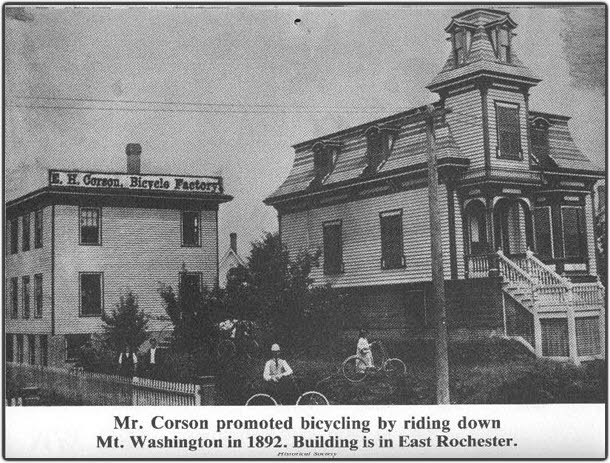
Collectors love commemoratives and there's an active market for the all the issues including the modern ones. Putting sets together of the pre-1982 coins is a daunting challenge in that there are 144 pieces with 50 different designs in the classic silver commemorative series alone. If you have some commemorative silver half dollars, they may be worth from a few dollars to hundreds, even thousands of dollars, depending on the rarity and demand for that type.
A Brief Overview of Silver Commemoratives
The World’s Columbian Exposition, intended to be held in Chicago in 1892 to observe the 400th anniversary of Columbus’ landing in America, furnished the opportunity for the first United States commemorative coin, the 1892 Columbian half dollar. As it turned out, the Exposition was not completed in time, and the gates of the fair were not thrown open to the public until a year later in 1893. Additional Columbian half dollars with the 1893 date were produced. In the same year a small number of 1893 Isabella quarter dollars were issued at the Exposition, and were the first and only commemoratives of this denomination.
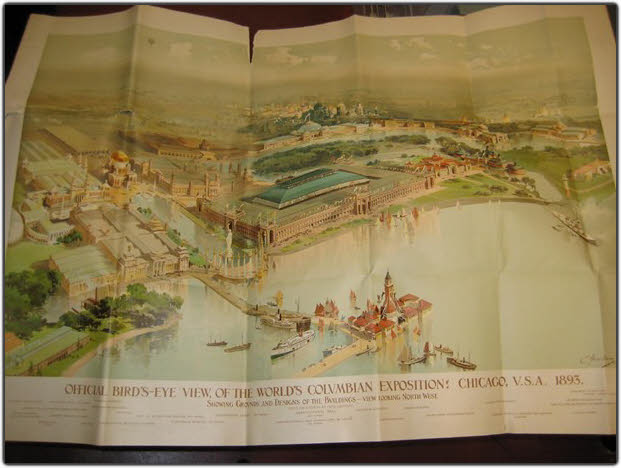
The next silver commemorative coin is the 1900-dated Lafayette silver dollar, all of which were struck in a single day on December 14, 1899, the 100th Anniversary of George Washington’s death. Conjoined portraits of Lafayette and Washington appear on the obverse of the coin. Next is the 1915-S half dollar issued for the Panama-Pacific International Exposition held in San Francisco in 1915, followed by the 1918 Illinois Centennial, 1920 Maine Centennial, and 1920 and 1921 Pilgrim Tercentenary half dollars.
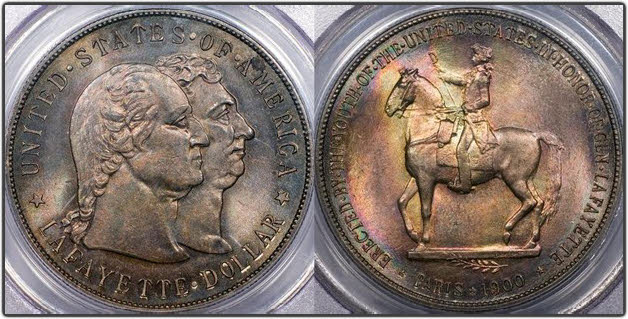
Production of commemorative half dollars continued through 1954, with the year 1936 being particularly memorable with the issuance of a dozen new designs. At the time, commemoratives were a nationwide fad, prices jumped virtually overnight, and thousands of new buyers jumped on the bandwagon. Soon a peak was reached, followed by a market decline. However, commemoratives were here to stay, and from that time onward they have been a foundation stone in American numismatics.
![May 13, 1936 Dallas, South Dakota. Buried machinery in a barn lot during the Dust Bowl, an agricultural, ecological, and economic disaster in the Great Plains region of North America. [url]http://commons.wikimedia.org[/url] dust bowl](/images/article_images/US_Coins/EarlyCommemoratives/dust_bowl.jpeg)
Congressional criticism of commemorative half dollars resulted in the suspension of issues after 1954. It was not until 1982 that production was resumed, this time, with more equitable marketing and pricing programs, with distribution handled by the U.S. Mint. Earlier, many coins had been distributed by private commissions and individuals, not all of whom acted fairly.
The MnS Joint Venture Seated dollar set
The MnS Joint Venture Seated dollar set is being put together by my father and I. We started collecting in 2002 or 2003 with liberty nickels and within 3 years we had a whole set, and up to 4-5 of some dates with a nearly complete second set. Time to look for a new series.
The seated dollar set was our second set we set out to tackle. It presented a challenge at a reasonable cost in the XF grade range that we started to look at. A few XF's in and a tough decision had to be made. Take the plunge or not. I was able to locate a choice XF 1873-cc in a dealers website and it was an easy decision. The coin was in our possession and quickly followed by an 1871-cc in XF. Some of the keys were down and there was no turning back from here.
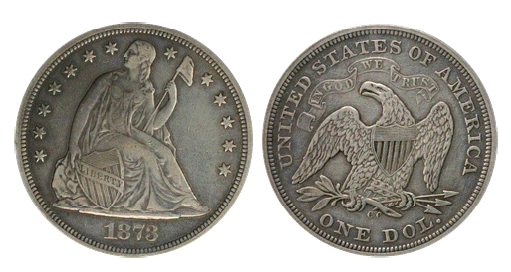
The next big step of the collection was the upgrading. Within a year or so our tastes changed from XF to AU-MS. Of course, for the seated dollars there is a BIG difference in price for MS over AU so it was convenient that my dad's company had taken some large chances that were starting to pay off.
The next milestone came in May of 2007. We walked by Tony Terranova's table at the St. Louis CSNS show and saw an AU-58 1852 that was gorgeous (and double the price of any other coin we had ever bought for the set!). We left the show with me dreaming and my dad scheming. Unbeknownst to me, my dad had gathered Tony's number and struck up a deal for the coin when we got back home.
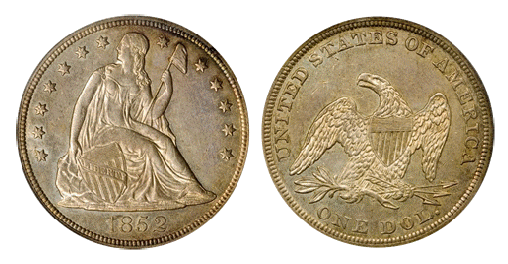
In May of 2008 another milestone was reached. An AU-55 1872-cc was purchased and was the last of the CC's needed. Two months later at the Baltimore show we upgraded our 1871-cc and with that we are pleased with these four coins!
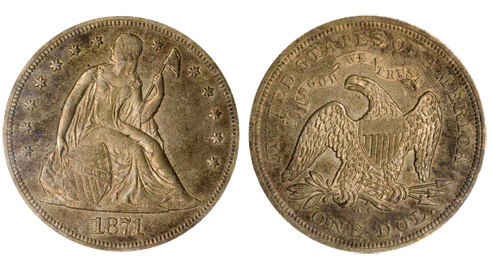
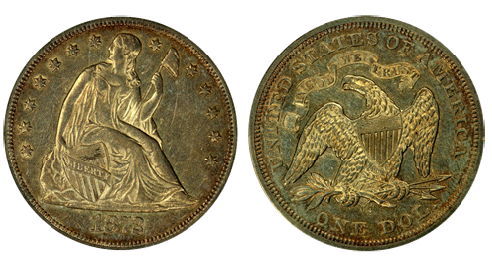
In October of 2008 a complete set was sold by Alpine Numismatics. From the sale we were able to pick up the 1851, 1870, and 1873 in MS-63 and the 1871 in MS-64. Thus completing the key dates (minus the 1870-s).
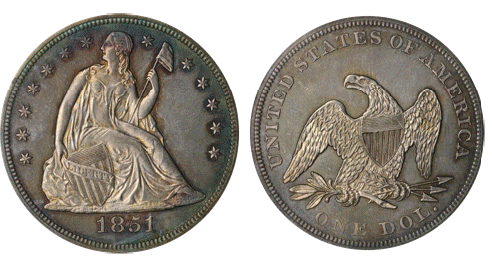
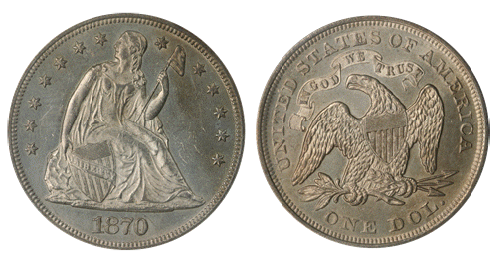
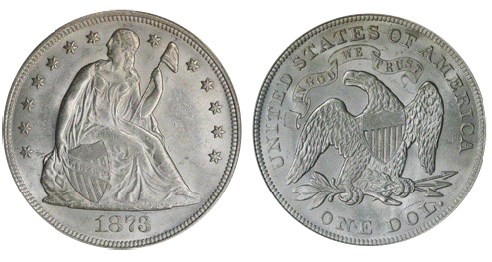
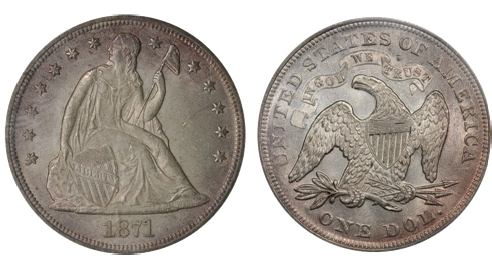
Since then, we have upgraded various dates and added a few more and currently are just missing the 1845, 1856, 1863, and 1872. We've seen and passed on many coins for these dates,
patiently waiting for the right coins to come along.
There are another 5-6 coins I'd like to upgrade before I consider the set "complete" and a few more that I would upgrade if the right coin came along. And who knows, at some point that elusive 1870-s might get added.
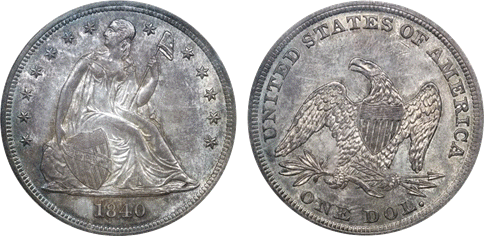
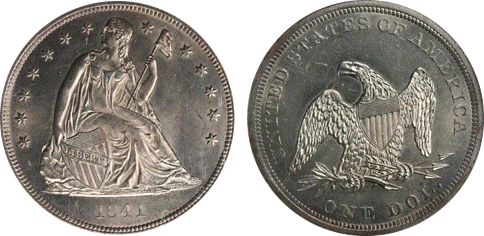
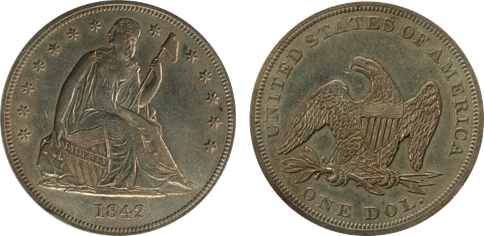
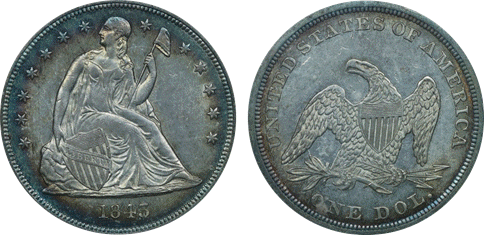
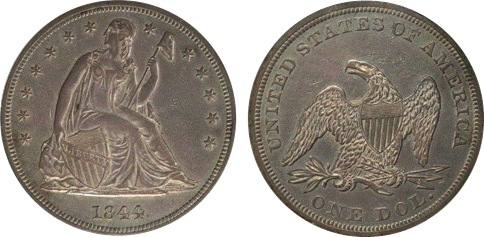
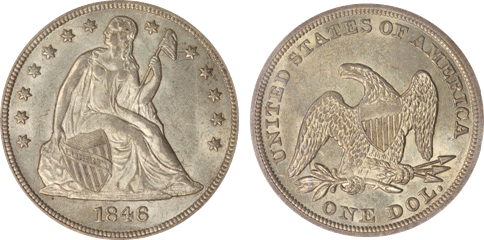
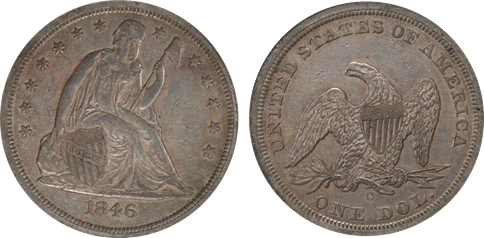
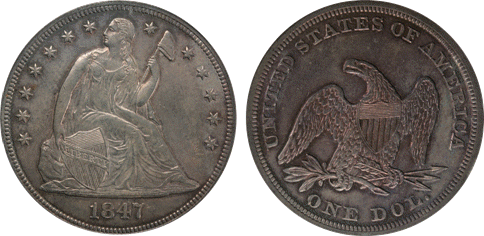
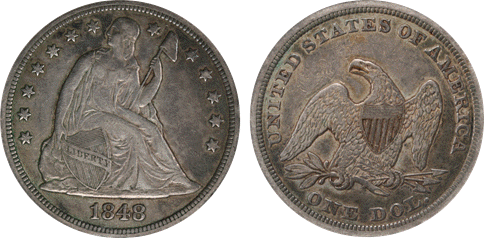
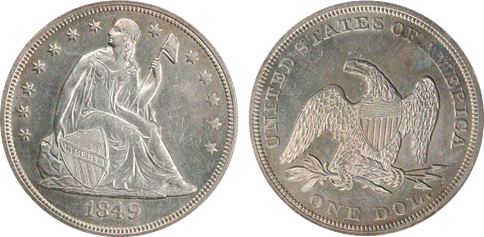
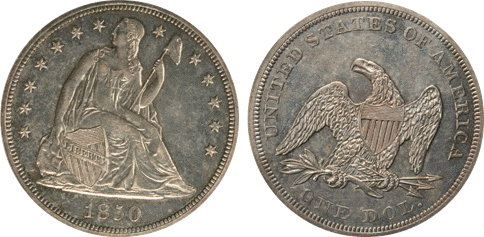
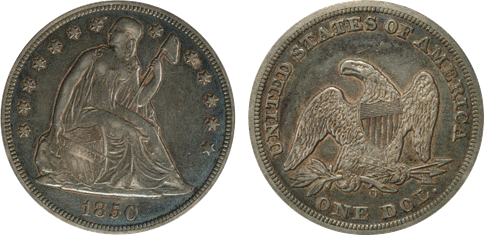
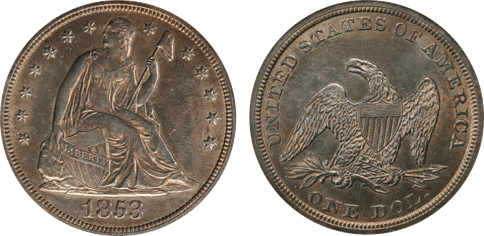
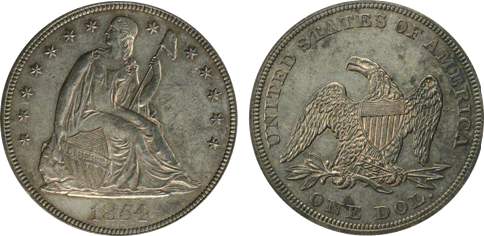
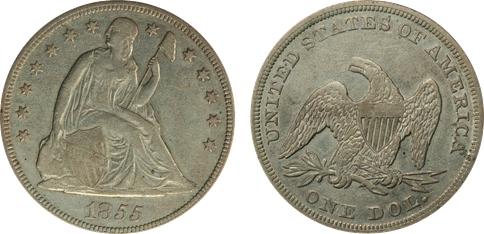
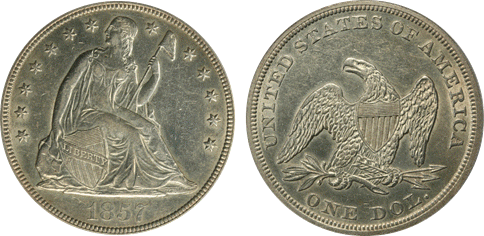
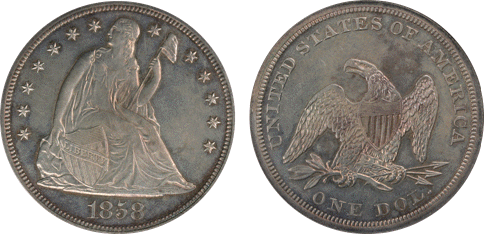
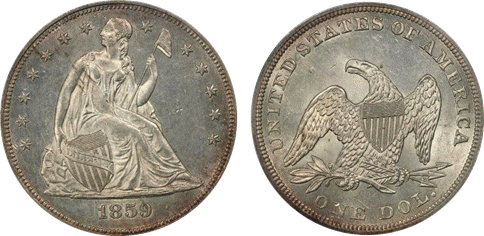
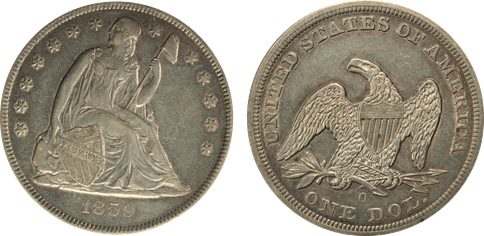
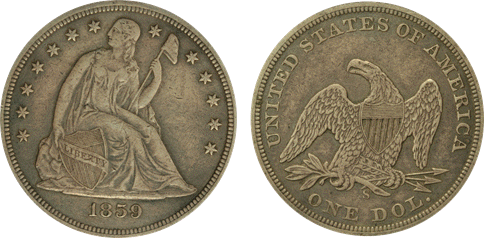
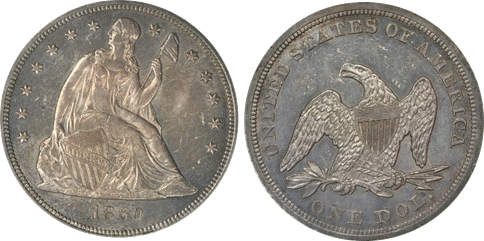
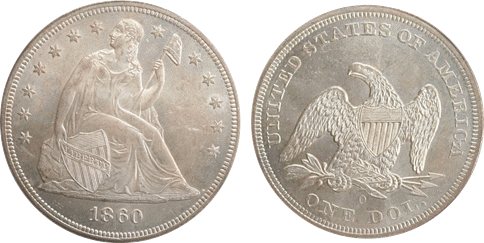
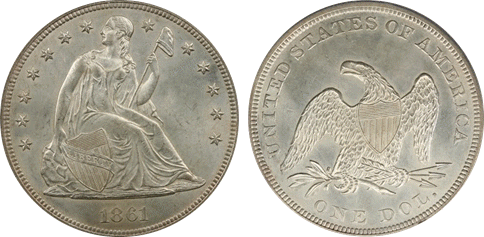
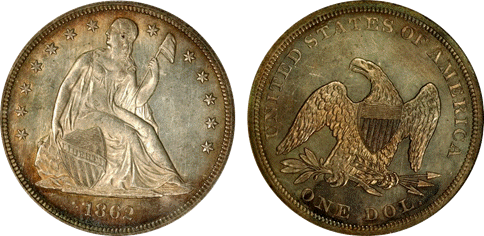
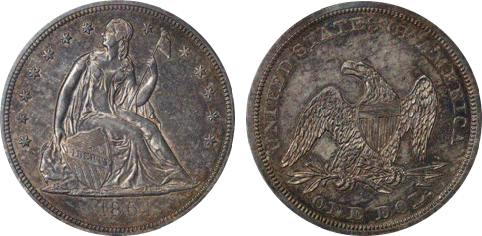
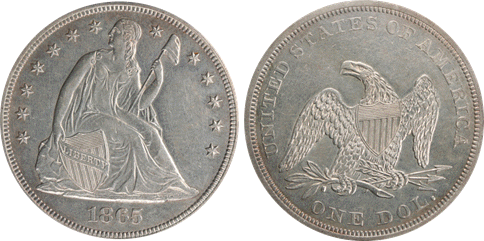
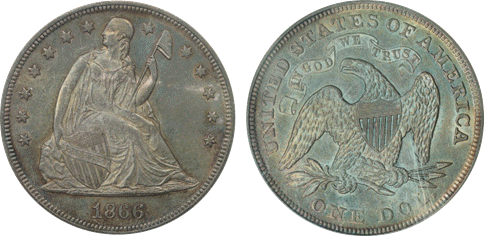
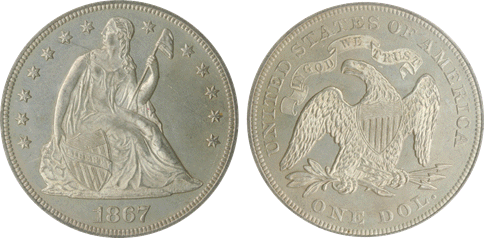
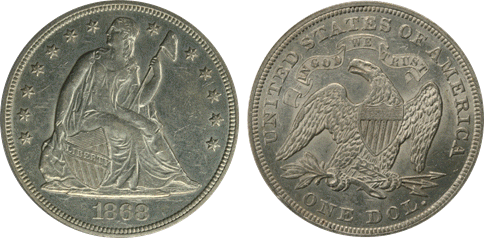
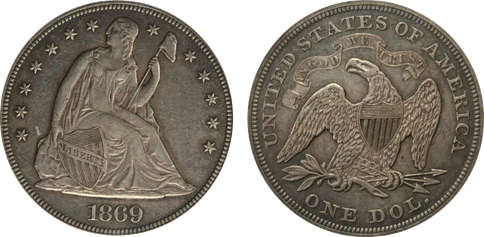
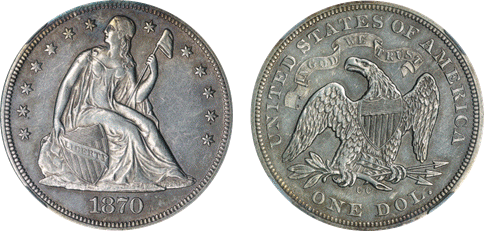
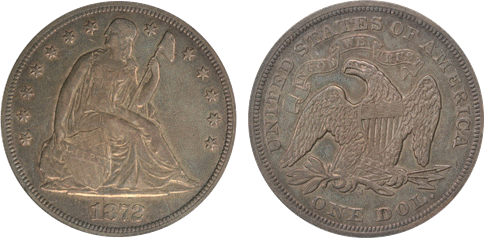
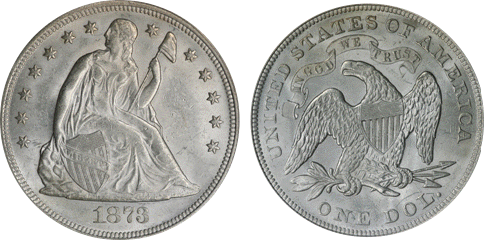

| Written by tradedollarnut all coin and images owned by tradedollarnut want to learn more? Please visit www.tradedollarnut.com |
I started on the Legend Collection in 1995. I'd been away from coin collecting for a few years but was actively thinking about returning. I happened to see an MS63 1875 S/CC trade dollar advertised by Legend Numismatics in an issue of Coin World that I'd picked up at a local coin store.
Trade dollars had always been one of my favorite series, ever since my Great Grandmother had given me a circulated 1877S that she'd kept in her teapot on the kitchen shelf. I remembered the S/CC as being a very rare coin that hardly ever came available and the price seemed quite reasonable for a PCGS certified coin. I called and asked if I could see it on approval and ended up purchasing the coin. Shortly thereafter, I purchased an 1873CC in PCGS MS63 that happened to come on the market.
I was now at a crossroads on only my second coin - to create a matched set of MS63 coins or go for the finest available (which is what the 73CC happened to be at that time). The event that tipped the balance was the only (at that time) PCGS MS68 trade dollar coming up for auction. Heritage allowed me to view the coin prior to the auction and I fell head over heels! What an amazing coin! I offered $100,000 on the spot, but was told it had to go through the auction process. I was on pins and needles until I received the call from Legend informing me that we'd bought the coin. Of course, the final price ended up being in the range of $130,000 but at this point I was hooked - the goal was now to build the finest collection of mint state trade dollars ever! Over the next five years, we completed the set with high quality coins and slowly replaced lovely examples with even better coins that were finest or tied for finest known.
I believe the goal has been accomplished, though I am always looking for that upgrade coin that comes available. In recent years we've added the Amon Carter 74CC, the Vermeule 73CC and several others. There are a few more out there that I know of, and there's always the chance of a new discovery coin coming along!
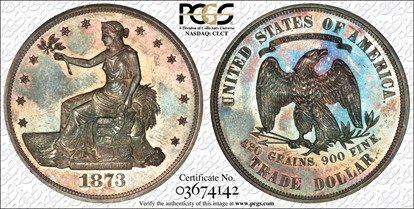 |
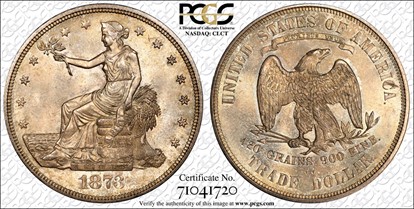 |
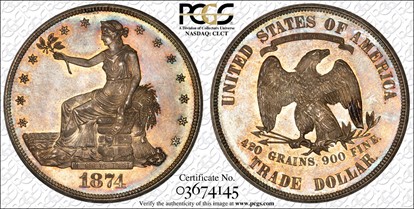 |
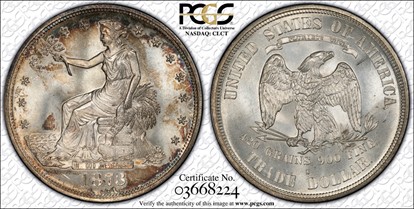 |
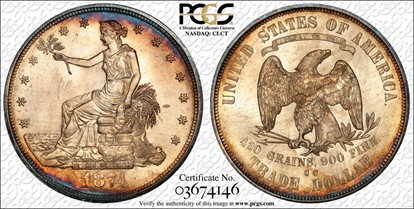 |
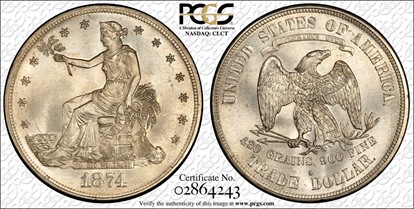 |
| A great story about my 1875 | 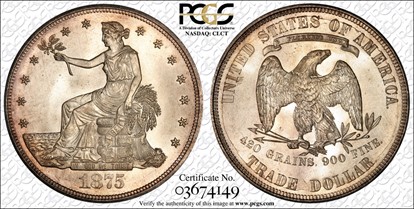 |
| Marc Emory's Special Coin |
Professional numismatist Marc Emory related the following concerning an especially nice 1875 trade dollar:
"As far as trade dollars go, there is a rather famous one I have handled (you did, too at one time), whose pedigree sounds like an old coin dealer's tall tale: In early February 1975, I was still living in Philadelphia after graduating from college the year before. Early one morning, Bob Riethe, who had a coin shop out in Plymouth Meeting Mall. called me up to crow about the finest trade dollar he had ever seen. He said he had just bought it from Alan Woglom in halfont, Pennsylvania for $600-no small sum at the time. He also said it was an 1875 Philadelphia Mint coin. I said to cut out the nonsense, and to tell me what it was he really wanted to talk to me about. He swore it was no joke, so I drove out there swearing plagues upon his house if this was an early April Fool. Furthermore, he owed me $1.240 at the time.
"I arrived at his shop, wading through the snow and slush of the parking lot, and came to his counter in a mood which can politely be described as less than jovial. To boot. he kept me waiting for ten minutes to explain to someone why
common silver dollars were common, and that he couldn't pay $20 for 1922 Peace dollars in VF grade. Finally, he pulled out the coin in question. All was forgiven-provided he realized I wasn't going to leave his shop without the coin. The 1875 trade dollar he showed me was (and remains today) one ol the most exquisite U.S. silver coins I have ever seen. l linally badgered him into letting me have it in lieu of all the money he owed me. I sold it (I wasn't too llush those days), to my great regret, to Maurice Rosen lor $1.900. Maurice worked for First Coinvestors at that time. Maurice left FCI soon after that, and the coin soon appeared in one ol their Pine Tree auctions. It was bought by Numismatic Associates of Ashland, Mass. for $3000+ and sold to A.H. Lamborn. His collection was sold (here's where you come in) as the "Fairiield Collection" by your lirm in 1977. The coin brought in excess of$7.000 this time.
"I lost track of it after that, as I was spending most ol my time overseas by now. I did see it appear later in an ad by Jack Hertzberg, enclosed in a PCGS holder and graded a conservative MS-68. Where it is now, I don't know, but someone should be happy with it. To this day it remains one of the two favorite silver coins I ever owned (the other was an 1855-S half dollar that went into James Pryor's collection).
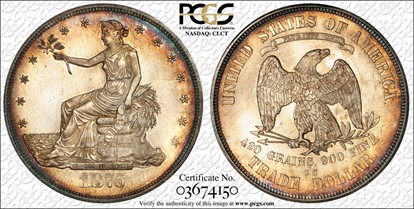 |
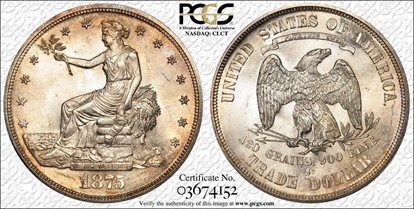 |
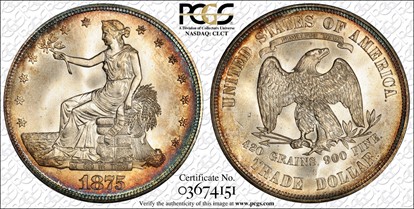 |
|
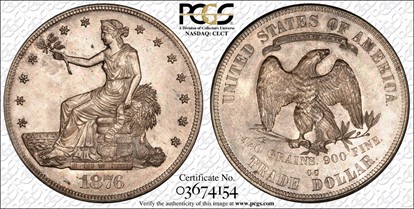 |
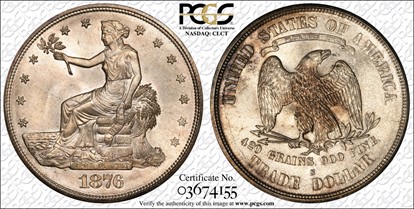 |
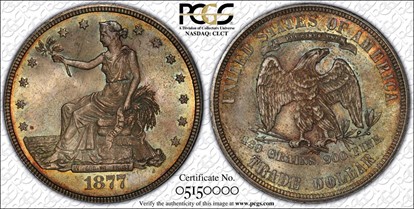 |
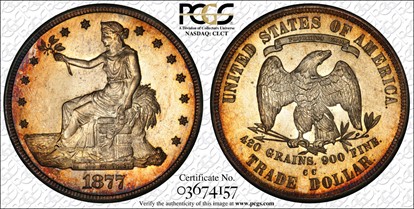 |
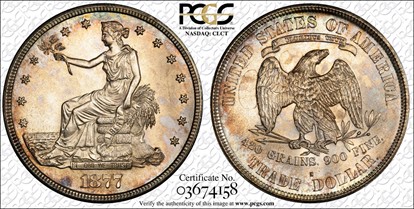 |
| My 1878-S | 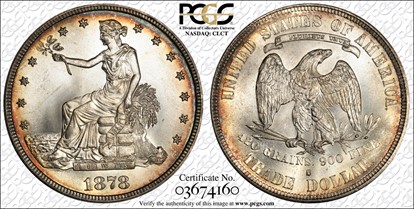 |
| MINI-HOARD OF 1878-S TRADE DOLLARS |
The following mini-hoard of 1878-S Trade Dollars is one of the many highlights offered in the 1990 ANA Sale. The story behind their discovery and inclusion in this sale is incredible. The consignor, (who we will call "Jim") one of the nicest and most pleasant people I've ever had the pleasure of meeting, had elderly next door neighbors that he was very close to. He would help and befriend them whenever the opportunity arose. Little did "Jim" know what was in store.
Upon the death of the elderly couple, "Jim" was named executor of the estate - what little there seemed to be - and two requests were made: all financial instruments were to be left to a local university and all personal property would go to the executor. "Jim" went to the bank and opened the safe deposit box. Not expecting to see a great deal, he was taken back by the wealth before his eyes. The wealth however appeared to be all financial and thus left to the university.
Among the tens of thousands of dollars in stocks and bonds there was also over $1 million in bearer bonds. Upon removal of all the papers. on the bottom of the drawer, just lying loose, were 25 1878-S Trade Dollars! As wonderful as this seemed, there was a dilemma. Were the coins "financial " and thus property of the university, or were they personal and thus the property of "Jim." After long discussions with the attorneys, it was decided that the coins would be divided equally - with 13 coins going to the university and the remaining 12 coins to "Jim."
The university immediately sold their coins to a local coin dealer. This dealer in turn sold them to a major west coast firm who submitted them to PCGS who in turn graded them mostly MS-65, with a few MS-64's and (2) MS-66. Point of fact every known 1878-S Trade Dollar grading MS-65 or higher (at the time of this writing) can be traced back to this hoard of 25 coins. The only exception being the lone MS-67, which. as justice would have it, is also included in this incredible sale!
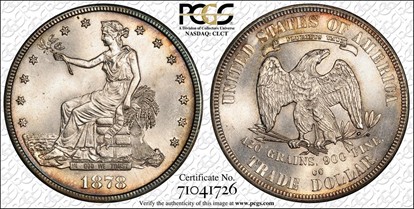
Page 1 of 4


